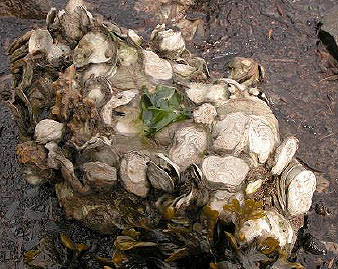 An important focus for Ted Grosholz involves the ecology and potential for restoration of native Olympia oysters Ostreola conchaphila (previously Ostrea lurida) in western estuaries. Estuaries in California have been heavily impacted by human activities that have resulted in substantial loss of habitat, invasion by non-native species, inputs of sediments and contaminants and other stressors that have resulted in substantial declines in ecosystem function. One important approach to restoring these functions is the restoration of native species. Historically, native oysters likely provided the same ecosystem services that have been documented for native oysters in the eastern U.S. including the provision of habitat for native invertebrates and fishes and improving local water quality. There is now substantial interest on the part of many local, state, and federal agencies and natural resource managers in improving the health of California estuaries by restoring native oyster populations.
An important focus for Ted Grosholz involves the ecology and potential for restoration of native Olympia oysters Ostreola conchaphila (previously Ostrea lurida) in western estuaries. Estuaries in California have been heavily impacted by human activities that have resulted in substantial loss of habitat, invasion by non-native species, inputs of sediments and contaminants and other stressors that have resulted in substantial declines in ecosystem function. One important approach to restoring these functions is the restoration of native species. Historically, native oysters likely provided the same ecosystem services that have been documented for native oysters in the eastern U.S. including the provision of habitat for native invertebrates and fishes and improving local water quality. There is now substantial interest on the part of many local, state, and federal agencies and natural resource managers in improving the health of California estuaries by restoring native oyster populations.
The Grosholz lab's research program now addresses climate change in the context of both limiting populations of native Olympia oysters as well as efforts to restore their populations. With funding from the NOAA/NERR Science Collaborative, and in collaboration with partners from San Francisco Bay NERR (Matt Ferner), Elkhorn Slough NERR (Kerstin Wasson) and UCD/SERC (Chela Zabin), they are investigating the effects of climate change variables on the future of restoration of this important foundation and fishery species in San Francisco Bay and Elkhorn Slough, CA. They are explicitly testing the influence of multiple climate change variables including sea surface and air temperatures, dissolved oxygen (hypoxia), and salinity on native Olympia oysters in both the lab and field settings. The Grosholz lab has conducted lab experiments examining the influence of temperature, dissolved oxygen and salinity extremes on native oysters. They have also quantified these variables and others in field plots at multiple sites in SF Bay and Elkhorn Slough. The project will also develop a targeted set of decision tools for user groups involved with oyster restoration using substantial input from these groups in tool development. This work breaks new ground by examining multiple climate change variables by parameterizing experimental levels, durations, and delays between stressors based on actual time series experienced in the field.
An additional focus of the Grosholz lab's work also involves large-scale restoration projects involving simultaneous restoration of native oyster and eelgrass habitat. This project is funded by the California Coastal Conservancy and involves partnerships with San Francisco State University (Kathy Boyer), UCD/SERC (Chela Zabin), USGS (Susan de la Cruz), PWA (Jeremy Long), Environcorp (Bud Abbott), and CA Coastal Conservancy (Marilyn Latta). They are conducting restoration in plots distributed across several acres at two sites in SF Bay, an East Bay site at Eden Landing and a Marin County site on TNC lands. At these sites, both eelgrass and native Olympia oyster restoration is the goal using a variety of experimental recruitment substrata to encourage native oyster recruitment and experimental plantings of eelgrass to enhance growth of eelgrass beds. These are conducted explicitly to test methods for effectiveness and to understand the potential impacts and synergies of restoring these two habitats concurrently. An additional goal is to also understand the potential for the oyster recruitment structures to reduce wave energy and protect shorelines from erosion.
